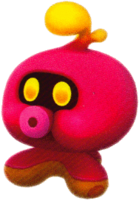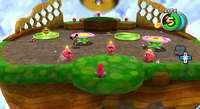Octoguy
| Octoguy | |
|---|---|
 Artwork from Super Mario Galaxy | |
| First appearance | Super Mario Galaxy (2007) |
| Latest appearance | Super Mario Galaxy + Super Mario Galaxy 2 (2025) |
| Member of | Octo-Army |
| Variant of | Octoomba |
Octoguys[1] are variants of Octoombas that appear in Super Mario Galaxy and Super Mario Galaxy 2. They resemble flapjack octopi, bearing a bulbous pink head, chubby cheeks, and rounder feet with octopus-like suckers. Their antenna has a unique asymmetrical shape.
History[edit]
Super Mario Galaxy[edit]
Octoguys debut in Super Mario Galaxy and its Nintendo Switch port, where they are marginally more common than regular Electrogoombas. If they are far away from Mario (or Luigi), they will pursue him, spitting a single rock in an arc towards him once they reach a specific distance; if Mario gets any closer, they will flee from him instead. After fleeing for some time, they will eventually tire themselves out and be forced to catch their breath for a short while. Octoguys can be defeated by any attack method except being shot with Star Bits, which stun them instead. They make a unique "squeaking" sound as they move.
Octoguys appear in the following list of galaxies and missions. If no mission is stated, Octoguys appear during all missions:
- Honeyhive Galaxy ("Bee Mario Takes Flight")
- Buoy Base Galaxy
- Bowser Jr.'s Airship Armada
- Gold Leaf Galaxy ("Star Bunnies on the Hunt", "Cataquack to the Skies")
- Deep Dark Galaxy ("The Underground Ghost Ship", "Bubble Blastoff", "Boo in a Box")
Super Mario Galaxy 2[edit]
Octoguys return in Super Mario Galaxy 2 and its Nintendo Switch port, behaving identically to their previous appearance. They are now rarer, appearing in only three galaxies. Octoombas now share their rock-spitting attack with Octoguys.
Octoguys appear in the following list of galaxies and missions. If no mission is stated, Octoguys appear during all missions:
- Boulder Bowl Galaxy ("Rock and Rollodillo", "C'mere, Goomba")
- Honeyhop Galaxy ("The Sweetest Silver Stars")
- Shiverburn Galaxy ("Octo-Army Icy Rainbow Romp")
Gallery[edit]
Model from Super Mario Galaxy
Naming[edit]
"Octoguy" is a combination of the "octo-" prefix shared by most of the Octo-Army, and "Shy Guy", alluding to their timid behavior. This allusion to Shy Guy is also present in its Japanese name.
Names in other languages[edit]
| Language | Name | Meaning | Notes |
|---|---|---|---|
| Japanese | タコヘイ[2][3][4] Takohei |
Octopus Trooper; compare 「ヘイホー」(Heihō, "Shy Guy") | |
| French | Poulbob[5][6] | From poulpe ("octopus") and "bob," an English term for gently swaying as well as a nickname for the masculine given name "Robert" | |
| German | Oktopod[7] | Octopod | |
| Italian | Polipotto[8][9] | From polipo ("octopus") and the diminutive suffix -otto | |
| Spanish | Octoguy[10] | - |
References[edit]
- ^ Browne, Catherine (May 23, 2010). Super Mario Galaxy 2: PRIMA Official Game Guide. Roseville: Random House Inc. ISBN 978-0-30746-907-6. Page 28.
- ^ Watanabe, Takashi, Noriko Oketani, Geasen Ueno, Kiyotaka Iwaya, Tatsuhiko Mizutani, Kensaku Tanaka, Mizuho Nitta, Junko Fukuda, and Kunio Takayama, editors (2007). 『スーパーマリオギャラクシー: 任天堂公式ガイドブック』. Tokyo: Shogakukan (Japanese). ISBN 978-4-09-227115-9. Page 402.
- ^ Tachibana, Tadashi, Isamu Horie, Shinji Kutsuzawa, Itaru Nakatani, Seishiro Fuwa, Kimihara Hongo, and Toshimune Suzuki (2010). 『スーパーマリオギャラクシー2 任天堂ゲーム攻略本』. Tokyo: ambit (Japanese). ISBN 978-4-8399-3630-3. Page 19.
- ^ Sakai, Kazuya (ambit), kikai, Akinori Sao, Junko Fukuda, Kunio Takayama, and Ko Nakahara (Shogakukan), editors (2015). 『スーパーマリオブラザーズ百科: 任天堂公式ガイドブック』. Tokyo: Shogakukan (Japanese). ISBN 978-4-09-106569-8. Page 127, 160.
- ^ Browne, Catherine (2010). Super Mario Galaxy 2 Prima le Guide Officiel. Translated by Yellow Media. Ligugé: Prima Games (French). ISBN 978-2-952-67394-5. Page 30.
- ^ Ardaillon, Joanna, and Victoria Juillard-Huberty, editors (2018). Super Mario Encyclopedia. Translated by Fabien Nabhan. Toulon: Soleil Productions (French). ISBN 978-2-3020-7004-2. Page 127, 160.
- ^ Scholz, Sabine, and Benjamin Spinrath, editors (2017). "Super Mario Galaxy" in Super Mario Encyclopedia - Die ersten 30 Jahre : 1985-2015. Translated by Yamada Hirofumi. Hamburg: Tokyopop (German). ISBN 978-3-8420-3653-6. Page 127.
- ^ Browne, Catherine (2010). Super Mario Galaxy 2 Guida Strategica Ufficiale (Multiplayer.it Edizioni). Translated by Christian La Via Colli, Francesca Noto, and Virgina Petrarca. Terni: Multiplayer Edizioni, Prima Games (Italian). ISBN 9788863551198. Page 28.
- ^ Sakai, Kazuya (ambit), kikai, Akinori Sao, Junko Fukuda, Kunio Takayama, Ko Nakahara (Shogakukan), and Marco Figini, editors (2018). Super Mario Bros. Enciclopedia. Translated by Marco Amerighi. Milan: Magazzini Salani (Italian). ISBN 889367436X. Page 127, 160.
- ^ Sakai, Kazuya (ambit), kikai, Akinori Sao, Junko Fukuda, Kunio Takayama, and Ko Nakahara (Shogakukan), editors (2017). "Super Mario Galaxy" in Enciclopedia Super Mario Bros. 30ª Aniversario. Translated by Gemma Tarrés. Barcelona: Editorial Planeta, S.A. (European Spanish). ISBN 978-84-9146-223-1. Page 127.





